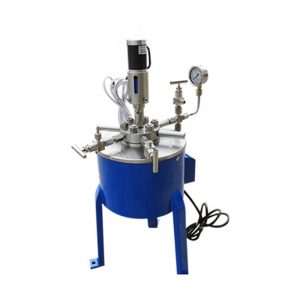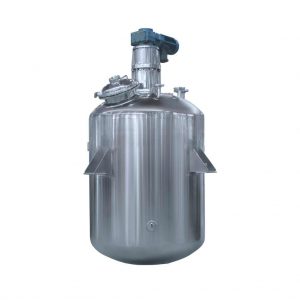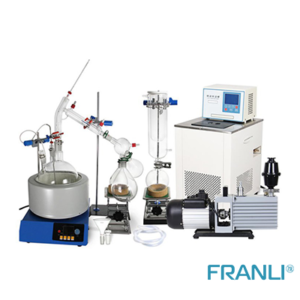Home » Glass Reactor: Single Layer, Double Layer, Triple Layer
Glass Reactor: Single Layer, Double Layer, Triple Layer
Chemical Reactor
Details of Chemical Reactor
- Using the latest reaction technology
- It has high temperature resistance, corrosion resistance, and high durability.
- Heating methods include steam, electric heater, high temperature heat transfer oil
- Using jacket, half pipe, fan coil, and other structures
Application: Chemicals, pharmaceuticals, dyes, pesticides, petroleum, food additives, etc.
The design of a glass reactor is critical to its performance. The vessel is typically made of borosilicate glass, which is resistant to thermal shock and chemical corrosion. The glass is reinforced with stainless steel or aluminum frames to prevent breakage during operation. The reactor is also equipped with a variety of accessories, such as stirrers, thermocouples, and ports for adding and removing materials.
One of the key advantages of a glass reactor is its transparency. The glass allows researchers to observe the reaction as it occurs, which is critical for understanding the kinetics and mechanism of the reaction. This can be particularly useful for reactions that are sensitive to light or require precise temperature control.
Another advantage of a glass reactor is its versatility. Glass reactors can be used for a wide range of chemical reactions, including synthesis, crystallization, and distillation. They can also be used for reactions that require high pressures and temperatures, such as hydrogenation and polymerization.
Glass reactors are also easy to clean and maintain. The borosilicate glass is resistant to chemical corrosion, which means that the vessel can be cleaned with a variety of solvents without damaging the glass. The stainless steel or aluminum frames are also easy to clean and can be sterilized if necessary.
There are several types of glass reactors available, each with its own unique features and advantages. Some of the most common types include:
1. Single-layer glass reactor: This is the simplest type of glass reactor, consisting of a single glass vessel with a stirrer. It is typically used for small-scale reactions and is easy to operate and maintain.
2. Double-layer glass reactor: This type of reactor consists of two glass vessels, one inside the other. The space between the two vessels is filled with a heat transfer fluid, such as water or oil, which allows for precise temperature control. Double-layer glass reactors are commonly used for reactions that require heating or cooling.
3. Triple-layer glass reactor: This type of reactor consists of three glass vessels, with the outer two vessels filled with a heat transfer fluid. The space between the inner and middle vessels is used for the reaction, while the space between the middle and outer vessels is used for temperature control. Triple-layer glass reactors are typically used for reactions that require precise temperature control and high pressures.
4. Jacketed glass reactor: This type of reactor consists of a glass vessel with a jacket surrounding it. The jacket is filled with a heat transfer fluid, which allows for precise temperature control. Jacketed glass reactors are commonly used for reactions that require heating or cooling, as well as for reactions that require high pressures.
5. Glass-lined reactor: This type of reactor consists of a metal vessel lined with glass. The glass lining provides excellent chemical resistance and thermal shock resistance, while the metal vessel provides structural support. Glass-lined reactors are commonly used for reactions that require high pressures and temperatures, as well as for reactions that are corrosive or abrasive.
Glass reactors are used in a variety of applications, including:
1. Chemical synthesis: Glass reactors are commonly used for chemical synthesis, including the synthesis of pharmaceuticals, fine chemicals, and specialty chemicals. They are particularly useful for reactions that require precise temperature control and high pressures.
2. Crystallization: Glass reactors are also used for crystallization, which is the process of forming crystals from a solution. They are commonly used for the production of pharmaceuticals and specialty chemicals.
3. Distillation: Glass reactors can also be used for distillation, which is the process of separating components of a mixture based on their boiling points. They are commonly used for the production of high-purity chemicals and solvents.
4. Hydrogenation: Glass reactors are commonly used for hydrogenation, which is the process of adding hydrogen to a molecule. They are particularly useful for reactions that require high pressures and temperatures.
5. Polymerization: Glass reactors are also used for polymerization, which is the process of forming polymers from monomers. They are commonly used for the production of plastics, adhesives, and coatings.
A glass reactor is a versatile laboratory apparatus that is used for a variety of chemical reactions. It is made of borosilicate glass and is designed to contain chemical reactions at high pressures and temperatures. Glass reactors are commonly used in the chemical, pharmaceutical, and biotech industries for research and development, process optimization, and scale-up studies. They are transparent, versatile, easy to clean and maintain, and come in several types to suit different applications. Glass reactors are critical tools for advancing scientific research and innovation in the chemical industry.
Welcome to send inquiry to us and let’s make a win win business together !
Guidelines For Chemical Reactor
FRANLI has several complete Chemical reactor production lines. Our Chemical reactor adopts the latest infinitely variable speed reducer device, the sealing device can be a mechanical seal, and the heating and cooling can adopt the structure of a jacket, half pipe, fan coil, etc., The heating methods include steam, electric heater, and high-temperature heat transfer oil to achieve different safe processing environments such as acid resistance, heat resistance, wear resistance, and corrosion resistance.

Laboratory Reactor: Guide to Stirring System
The laboratory reactor is composed of a pot body, a pot cover, an agitator, a jacket, a support and transmission device, a shaft seal device, etc.

Overview of Laboratory Reactor
Laboratory reactors, also known as lab reactors, are essential tools in scientific research, product development, and process optimization. These reactors provide a controlled environment for conducting chemical reactions, mixing, dispersing, and homogenizing processes.

What is A Stainless Steel Reactor?
Stainless steel reactors are essential equipment in various industries, including chemical, pharmaceutical, biotechnology, and food processing.

Glass Reactor & Chemical Equipment
Glass reactors are essential equipment widely used in the chemical, pharmaceutical, and biotechnology industries. They come in various types, suitable for different applications.

Operating Guide for Laboratory Reactors
Laboratory reactors play a crucial role in chemical research and development. Understanding the proper operating procedures is essential to ensure accurate results and maintain a safe working environment.

Glass Reactors and Selection of Stirring Blades
Glass reactors, also referred to as glass reaction vessels, are vessels made from high-quality borosilicate glass material.
